Berg Early Specialty Gouges
Article contributed by Randall Nelson
I got my very first Berg gouge when I was an art student at Pratt Institute in Brooklyn, NY in the early 70’s. I had gone to a business called Sculpture Associates, on the lower east side of Manhattan, right off of Houston Avenue. They sold all types of art materials, but specialized in stone and wood carving tools made in Germany and Italy. As a sculpture major, I was always on the lookout for nice tools, even though I never had any extra money. I had gone there hoping to pick up some small gouges for doing wood block prints, possibly a “returned” set that I could get cheap. While poking around the back of the shop I noticed the proprietor’s work bench in an alcove against the back wall. There was a project he was working on and some of his tools were on the bench. One was a ¾” Berg gouge with the end of the handle all splintered from being hit, for the hammer ring was gone. I grabbed it off his bench and went up to the front counter.
“How much for this one?” “Hey man- that’s mine- it’s not for sale!” “No- no- how much for this one?” I insisted, waving it in the air. “Look- the handles all broken!” “Really- I don’t want to sell that one- it’s great for carving slate.” “What? How could you do that- this is a Swedish wood chisel, not a stone carving tool! You broke the handle using a sledge hammer on it!” “Yeah- I was going to put a new handle on it, maybe turn some Cocobolo…” I knew he was weakening. “Forget the new handle- how much do you want?” I ended up buying it from him for around $15.00, which seems cheap now but that was my food budget for the whole week. But at least I now had that rarest of items- an actual Berg gouge.
Several weeks earlier I had gotten my first Berg chisel, a 2” Shark-O-Lite butt chisel. It was given to me by one of my teachers, a welder who had found it in the building he had rented as his studio and didn’t mind giving it away to me. So maybe these Swedish tools really were available, if you just kept your eyes open!
I still have that first gouge and have slowly added to my Swedish chisel collection, buying them whenever I could find them, if I could afford them. Carpenter’s chisels would show up, usually at flea markets or old tool shops, but not gouges. I didn’t know it at the time but it would be nearly twenty years before I got my next Berg carving gouge. Of course, all that changed when I finally discovered Ebay in 2004.
Several years ago I saw 3 small chisels on Ebay, listed as Lathe Tools. They obviously were not- they were small, delicate gouges but seemed unusual; two had strange, blocky looking wood handles and the third looked like it might be a Buck Brothers chisel. The handle was very similar in design to the carving tool handles of an old American brand, Buck Brothers, but those were always made of maple or apple wood. I looked closer, then hit the “mouse over- zoom” button to magnify the picture. I saw the ghost of a fish on the blade of the “Buck” tool and what could be two lines of knurling on the brass ferrule- but both Berg and Buck had done that. However, the ferrule was not the right length for a Buck, it was shorter- just like a Berg. I put in my bid, then doubled it, then sweated out the six day wait. I won! No one else even bid.
When they finally arrived, all three were Bergs! All were in brand new, shiny, unused condition, like they had just come straight from the factory, never sharpened or used. I had never seen these types of handles before. The tool with what I had thought was a “Buck” style handle was obviously not- the handle was small and made of plain Birch. The chisel also had “SWEDEN” and a shark stamped on the blade, but the shark was a very strange style- more like a fish with a big mouth than the usual shark image I was used to. It was stamped “E. A. BERG” in tiny letters on the back. The other two chisels had no shark stamp at all; they both said, in one line, “E. A. BERG ESKILSTUNA”. One of these was also stamped “SWEDEN” on the back. There was no sign of any sticker on the handles, although the tools looked absolutely brand new. Although I did not realize it at the time, I had just purchased tools that would represent, for me, two new sub-genera of E.A. Berg tools.
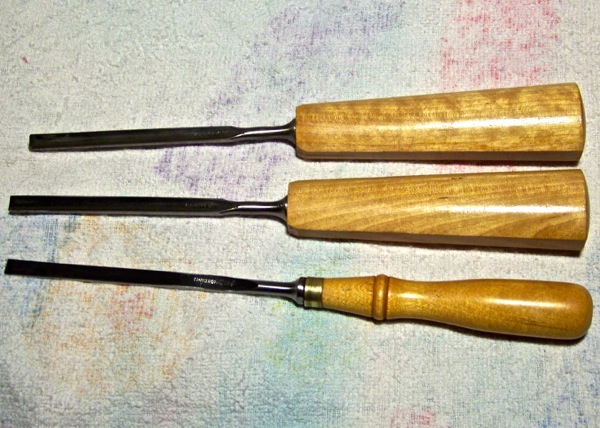 The Three Bergs, Listed As Lathe Tools
The Three Bergs, Listed As Lathe Tools
The first new discovery was represented by the “Buck Brothers Style” handle, which I have never seen represented in any Berg catalog but that I am convinced was a Berg product. After several years of searching I have four Berg carving gouges with variations of the “Buck Brothers Style” handle, which I now refer to as the Berg “Art School” handle. These handles are all found on light, delicate hand carving tools which were made especially for sculptors and wood carvers. They were not meant to be hit, only pushed with the palm of the hand, as opposed to the more typical carpenter’s gouges which have blades and handles that are more robust and made to be struck with a mallet or a hammer. They were made for uses such as timber framing and boat building, as well as other more artistic endeavors such as sign carving and pattern making. The four examples of the “Art School” tools are all made with handles of plain Birch, not the showy Masur Birch more typical of Berg handles, yet they are still comfortable to use and quite elegant in appearance. Each of the chisel blades is marked with an early Berg shark variant with a large, open mouth; what I refer to as the “Basking Shark” stamp. Berg probably used variations of this stamp from the turn of the century into the late 1920’s, so that is when these tools are from, certainly before the switch to the “Modern Shark” stamp came about in the 1930’s.
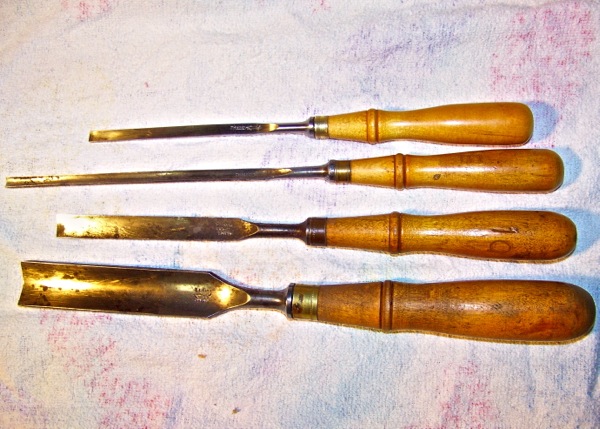 Four “Art School” Handled Bergs
Four “Art School” Handled Bergs
The second new discovery involved the gouges with the wood block handles and no shark stamp on the blades- I think they are slightly older and were possibly made for an even more specialized purpose. They are all just stamped, in very small letters, “EA BERG SWEDEN” or “EA BERG ESKILSTUNA”, but no shark stamp.
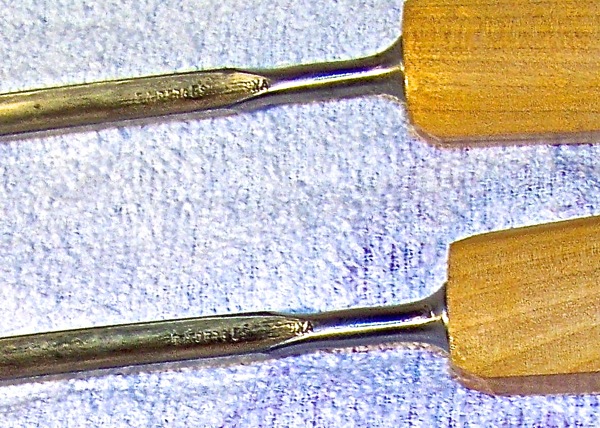 “No Shark Stamp” Berg Gouges – Stamped “EA BERG ESKILSTUNA”
“No Shark Stamp” Berg Gouges – Stamped “EA BERG ESKILSTUNA”
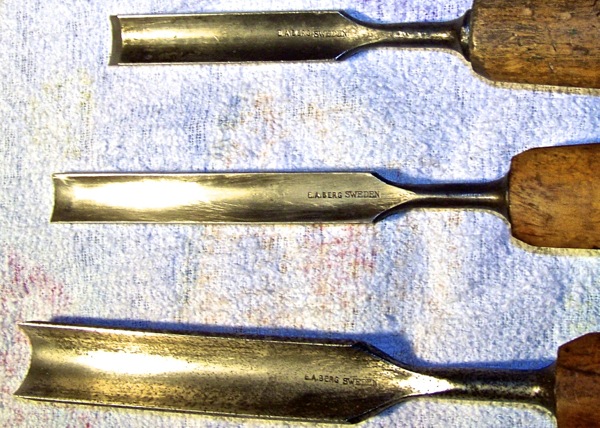 “No Shark Stamp” Berg Gouges – Stamped “EA BERG SWEDEN”
“No Shark Stamp” Berg Gouges – Stamped “EA BERG SWEDEN”
These are the only Berg gouges I have ever seen that do not have any shark imprint. I believe they may have been made especially for use in the Sloyd woodworking classes as part of the Swedish National Youth Education Program. These classes ran from the 1880’s through the 1930’s in Sweden, mainly to introduce the youth of the nation to various forms of material production, in preparation for joining the work force of an industrializing nation. These tools may have been made expressly for use in those shop classes for boys. The blades are also somewhat smaller and lighter than the standard Berg carpenter’s gouge. The block style handle is a traditional design for shop use, since it helps prevent the tool from rolling off the bench. Why the tools do not have a shark stamp is unknown, possibly the school system wanted them as plain as possible, or just didn’t want any company logos appearing on Sloyd class tools. I do know that every example of these “Sloyd gouges” that I have found has had the block type handle, which was available from both Berg and from Jernbolaget; it appears in the Berg 1936 catalog as well as the Jernbolaget 1927 catalog.
Besides being smaller than normal, both of these styles of gouge exhibit another shared trait- numbers stamped prominently on the handles. Of these two designs of gouge I have nine tools total, yet three of them display numbers stamped into the wood of the handles, on the side that would be facing up when they are laid on the bench.
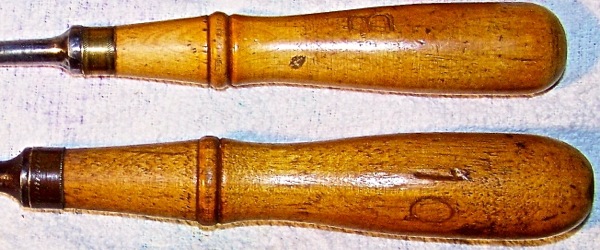 “Art School” Handles Stamped with the Numbers “3” and “10”
“Art School” Handles Stamped with the Numbers “3” and “10”
This is typical of how a set of tools would be marked for a workshop or classroom. The numbers would help the instructor quickly identify to the students which tool they should use for a particular application or procedure, as well as being an aid for putting everything away at the end of a class or work day. It also indicates that the tools were probably purchased as a set and marked at the factory, for the large numbers that appear on the handles are all practically identical in size and type face.
I have 45 other regular Berg gouges and only one of them has a factory number stamped on it, so this is not a usual thing. Every school in Sweden that had a woodworking program as part of their Sloyd curriculum probably had at least a basic set of five or six gouges, as well as regular chisels and some hand planes. The 1927 Jernbolaget catalog lists their two smallest sizes of hand planes as being especially for Sloyd. The catalog also states that gouges are available in sets of six, nine and twelve. Berg probably did this also, but it seems they did not include as much specific written information about possible ordering options that were available besides what was shown in their catalogs.
Examples of unique tool designs, made by Berg but never displayed in their catalogs, continue to show up from time to time, such as a set of cranked neck pattern makers gouges that was for sale recently. These items are proof that Berg was willing to do special custom work.
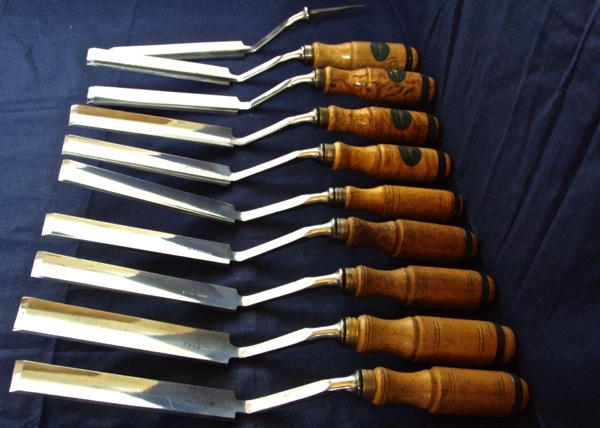 Berg Pattern Makers Chisels (Photo Courtesy of Kim Malmberg)
Berg Pattern Makers Chisels (Photo Courtesy of Kim Malmberg)
The idea that the “no shark stamp” gouges were made for the Swedish Sloyd Program is my idea, as a possible explanation of why Berg would decide to make tools without their customary shark stamp. I can easily imagine some bureaucrat within the Swedish Department of Education requiring that all companies that wished to supply tools to the Sloyd program must eliminate all decorative company elements from their tools, so as to reduce cost per item. If you could save even five cents per tool, this would still add up to a sizable amount over time.
As to how these tools finally ended up for sale on Ebay in the USA, I have no real idea. I had been dealing with Ebay for several years before I realized that you could actually contact the seller and request more info about an item, and so lost the opportunity to find out from the seller the history of many of the tools I had purchased. However, if these chisels were used in the Sloyd Program, what would have happened to those tools when the Programs were finally canceled by the Government during the Depression? Some would have been taken by faculty or staff, others might have been distributed to the last students involved with the Program. Many may have been collected for metal drives, as happened in the USA. A lot of what I have written in this article is speculation, based on my own experiences and observations. As new facts come to light I hope that some of the questions I have raised in this article will be resolved.
Article contributed by Randall Nelson
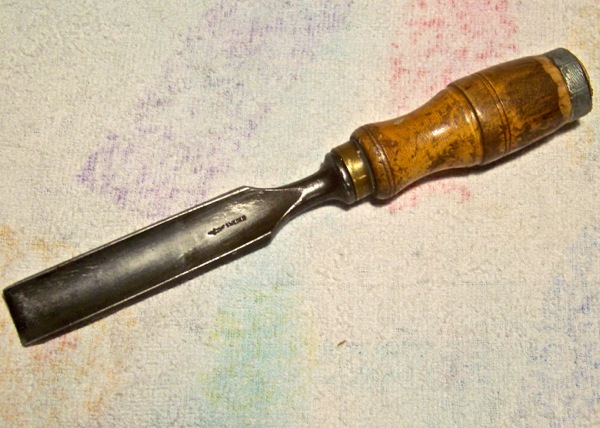

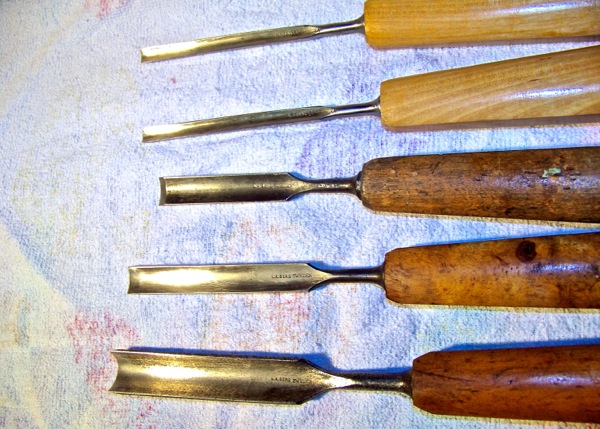

Just as an additional observation about the idea of the Berg company and the Sloyd Education Program in Sweden- I recently got re-prints of two catalogs, both printed in Swedish. They are the EA Berg catalog from 1899 and the Bacho catalog, undated but probably printed in the 1960’s. Each has a section on woodworking knifes, and each shows an item that is the same in both catalogs; No. 2B Stockholms slojdskolors modell, which of course means Sloyd Student Model. This is not a big discovery ,but it does show that Berg was conciouse of the Sloyd (slojd) Program, and it may be the closest thing to proof of their involvement with it that I will ever find. If any of you have access to other documentation I hope you will share it here on the Forum.
Robert J. Andersen: I have quite a few extra Berg gouges. If you are a carver then you already know how well they work. Contact me at rnelsonstonecarve@gmail.com
Great information. I’ve been looking to expand my Berg collection I inherited from my father. He was a journeyman carpenter in Denmark and brought his tools with him to usa. I carve and really need gouges and would prefer to add some Bergs yu o my fathers set. Do you have any available?